Hundreds of years of mining in Pennsylvania have left thousands of former mining sites in need of reclamation to then be stabilized by either reforestation or revegetation. Learn how DEP and their partners are working to bring mining-scarred lands back to their original state, one tree at a time.
The Need for Reforestation
By its very nature, prior to 1977, the process of surface mining for coal and or other minerals drastically changed the landscape where it took place. Trees and other vegetation were cleared away, and topsoil and layers of rock removed to access the mineral to be extracted. Once the minerals had been extracted, the coal and or mineral mine was abandoned, leaving behind a blighted landscape and environmental damage such as erosion, if not properly remediated. Whether by wind erosion or water erosion, soil, culm, mine spoil or refuse has the potential during a rainstorm to be washed into streams, lakes, rivers, and onto roadways and private property. The trees and vegetation removed when these mining sites were cleared would have aided with the erosion problem while also helping to combat global warming and climate change.

Prior to 1977, coal mine owners could simply abandon their mines when finished with them and walk away from any environmental damage that they were responsible for, leaving behind thousands of abandoned mining sites in Pennsylvania. To address this problem, in 1977 the U.S. Congress enacted the Surface Mining Control and Reclamation Act (SMCRA) requiring post approved and permitted 1977 (coal only) mine owners to remediate any environmental damage that they caused. To comply with the law, mining companies worked to revegetate and reforest the land, but many merely met the letter of the law, meeting the requirements for bond release by planting less than desirable trees and heavy grasses rather than properly revegetating and reforesting the sites. The focus at the time was on preventing erosion, but vegetation other than grasses had a hard time growing in those conditions. Such sites are known as legacy coal sites and along with pre-1977 abandoned coal mine sites, they comprise between 150,000-200,000 acres of formerly mined land in Pennsylvania in need of reforestation.
The Appalachian Regional Reforestation Initiative (ARRI)
Recognizing the need for reforestation of mining sites, in 2004 the Office of Surface Mining Reclamation and Enforcement (OSMRE) launched the Appalachian Regional Reforestation Initiative (ARRI) dedicated to restoring forests on legacy coal mined lands, eligible pre-1977 abandoned coal mine sites, and post-1977 active surface coal mine permits in the eastern United States. ARRI is a joint effort between OSMRE, state agencies including the Pennsylvania Department of Environmental Protection (DEP), industry partners, environmental organizations, academia, and landowners.
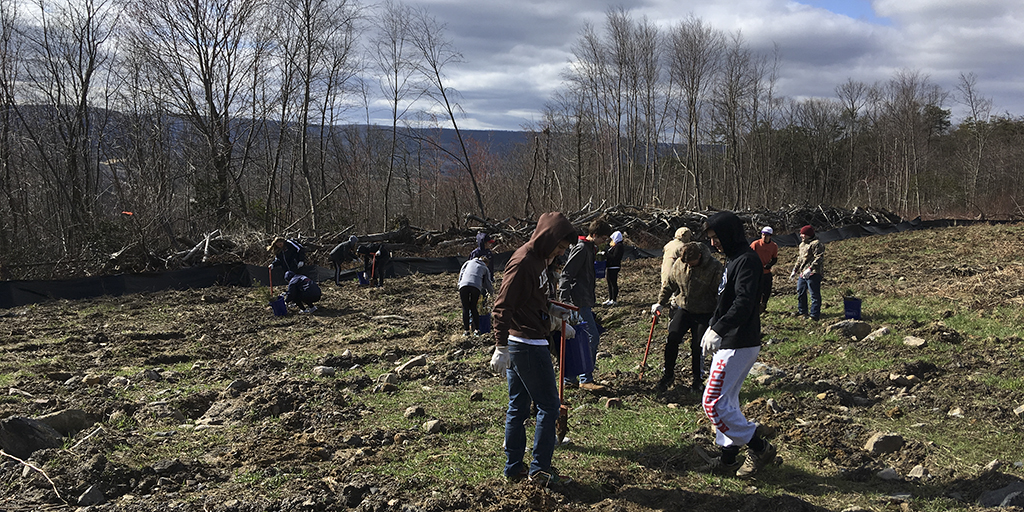
Utilizing a technique known as the Forestry Reclamation Approach (FRA), ARRI works on three categories of surface coal mine lands: post-1977 active surface coal mining operations, pre-1977 abandoned coal mine lands projects, and legacy coal sites. Since 2004, ARRI has reforested thousands of acres of reclaimed coal mined land throughout Appalachia to restore the areas to their natural appearance while gaining the many benefits the newly planted trees seedlings will provide, such as removing carbon dioxide from the air and helping to conserve water resources. DEP’s Mining Program utilizes the Forestry Reclamation Approach and works closely with OSMRE in mine land reforestation efforts here in Pennsylvania.
DEP’s Reforestation Efforts
Sites in need of reclamation are inventoried by DEP’s Bureau of Abandoned Mine Reclamation and given a priority number from one to three based on environmental or health safety, with one being the highest priority. After a site has been chosen, the goal is to try to get a blank slate on the vegetation to start over. If present, invasive species of plants (which are harmful to the natural ecology) and cool season grass which had been planted by mining companies and are not native to the area, are eradicated. Mine spoils that had been regraded and compacted to backfill coal highwalls by mining companies and qualified low-bid abandoned mine land contractors during their efforts at remediation, must be loosened by a process known as ripping. A large farm tractor or bulldozer is used to rip anywhere from three to five feet in the ground, loosening up three to five feet of top material which allows the trees to establish a root structure.
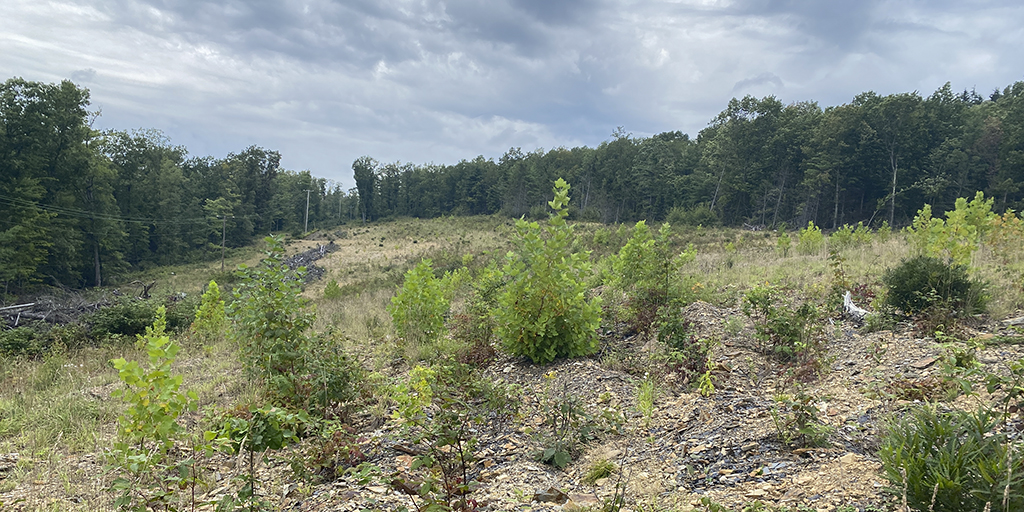
Once the mine spoil is uncompacted and ready, the next step is to plant 100% native tree seedlings. Typically, 70% of the tree seedlings will be hardwood (such as oak, hickory and maple) and early successional tree seedlings, 20% conifer component-evergreen tree seedlings, and 10% wildlife shrubs, although this ratio may vary depending on what the landowner is looking for. The tree seedlings begin to grow as soon as their roots are in the ground, with their rate of growth influenced by factors such as the amount of moisture and nutrients available to them. Hungry elk and deer take a toll on the trees planted, so much so that extra trees must be planted to make up for the trees consumed by herbivores.
Within three to five years after planting, early indications of the forest begin to establish. Between years 10-15, some canopy closure begins to appear, and after 25-30 years the late successional trees also begin to display some canopy closure.
Thanks to the efforts of DEP and their partners, Pennsylvania sits at the top of the Appalachian states for reforestation. Representatives from Kentucky, Tennessee, Virginia, West Virginia, Maryland and Ohio have sought out DEP staff to learn DEP’s approach to reforestation.
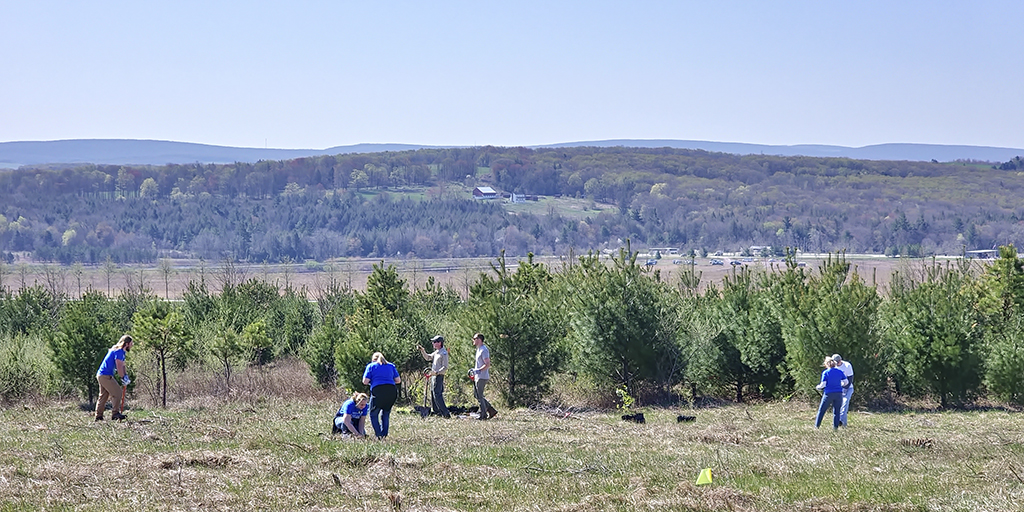
Partner Organizations
DEP partners closely in this effort with the non-profit organization Green Forests Work whose mission is to restore healthy and productive forests in formerly mined lands in Appalachia. Green Forests Work does much of the funding acquisition, working with agencies such as the Arbor Day Foundation, One Tree Planted, and the Bezos Earth Fund. Other funding sources include the Pennsylvania Environmental Council, the Foundation for Pennsylvania Watersheds, the Susquehanna River Basin Commission, and the National Fish and Wildlife Federation.
The Chesapeake Bay Foundation is another major partner in the reforestation efforts, providing trees and assistance with planting. DEP and the Chesapeake Bay Foundation are members of the Keystone 10 Million Trees Partnership, an organization with the goal of planting 10 million trees in Pennsylvania by the end of 2025.
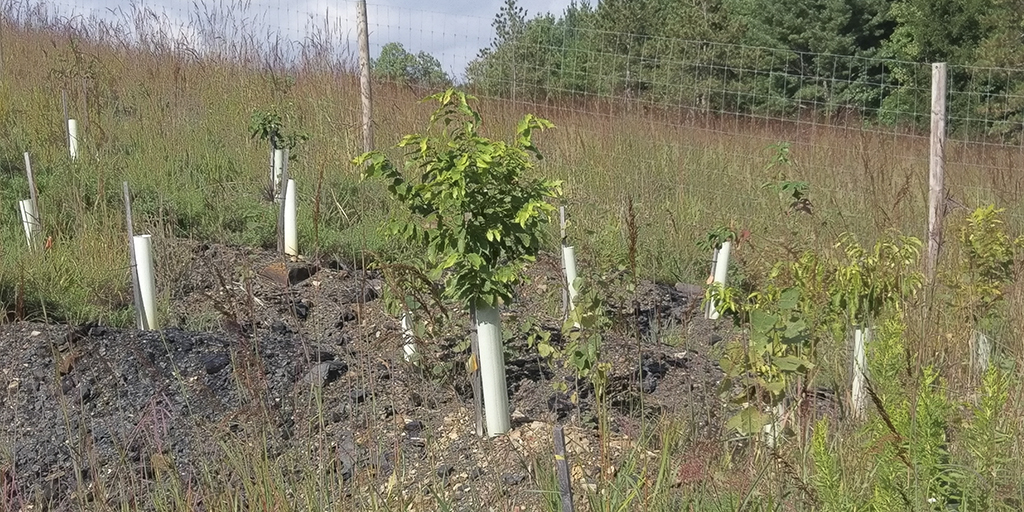
Challenges
While securing funding for reforestation efforts can be at times challenging, at present the biggest challenge is finding enough people to do the work. During DEP’s most productive year of reforestation, over 400 acres were reclaimed, however this figure could have quadrupled if more people were available to put the projects together and work on them.
The post-1977 active surface coal mining industry can be at times noncommittal to accepting the new techniques of the Forestry Reclamation Approach despite the proven economic and ecological benefits. Utilizing the FRA techniques, mine owners would save money in the early stages of the project, potentially get to bond release quicker, and have fewer problems down the road.
Healing a National Memorial
The crash of hijacked airliner Flight 93 on September 11, 2001 in Somerset County, Pennsylvania and the heroism of the passengers and crew is a story known to most everyone. Less well known is the fact that the crash occurred on the site of a former post-1977 permitted surface coal mine which is now the location of the Flight 93 National Memorial, dedicated to honoring the lives lost and their heroism on that fateful day. Led by the non-profit organization Friends of Flight 93, over 150,000 tree seedlings have been planted at the Memorial over a 10-year period. The reforestation efforts at this site have had the dual purpose of healing the land from the effects of mining and also from the emotional scars caused by the crash of Flight 93.
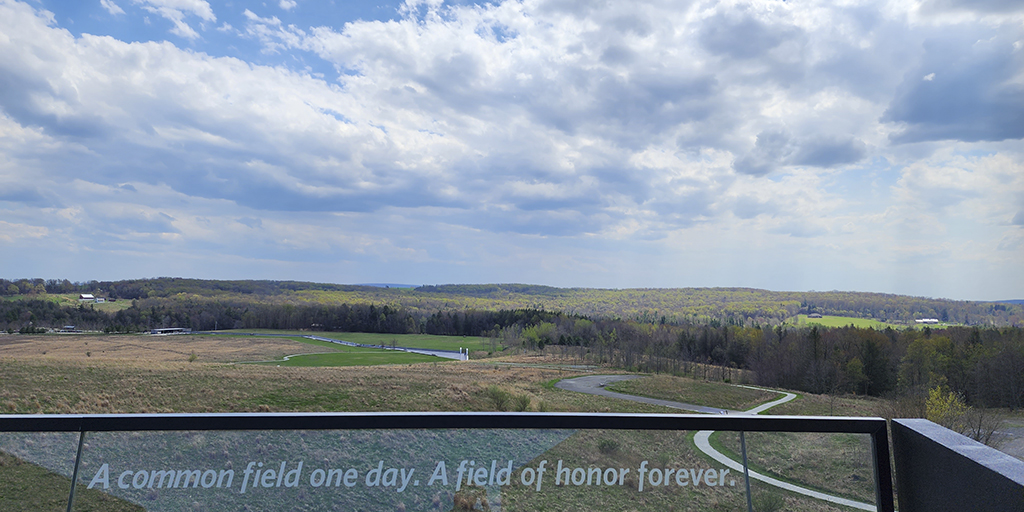
While all reforestation efforts are worthwhile and rewarding, the work done at the Flight 93 Memorial has proven to be a deeply moving and rewarding experience for the participants given the significance of the location. Mineral Resources Program Specialist Eric Oliver was the key DEP staff member involved with reforestation projects at the Flight 93 Memorial and all other DEP involved efforts. He summed up the efforts of the volunteers and the significance of their work at this unique location: “The work that you do here will be visible for many generations to see when they visit the memorial. While we are continuing to heal from the events that took place on September 11, 2001, your work here is also allowing the land to heal from the mining that took place. I can’t think of a better tribute to the heroes and families of Flight 93 than what has developed at this memorial.”
On April 21, 2023 an Earth Day Project took place where Friends of Flight 93 volunteers, DEP and OSMRE staff planted 1,500 native tree seedlings as well as 625 shrubs and roughly 2,500 wildflower plugs. While the main plantings are now finished, it is anticipated that small plantings will continue for many years to come.
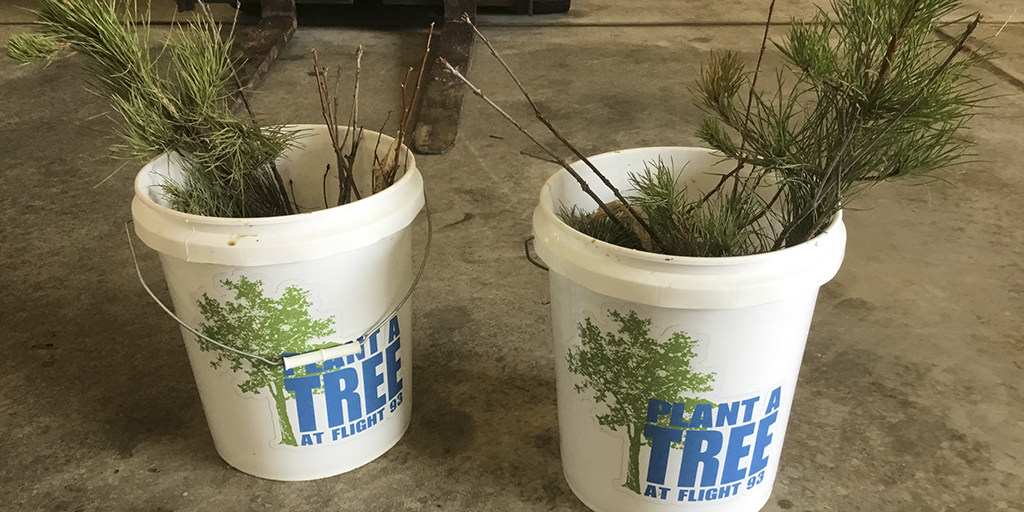
More Work Remains
“The best time to plant a tree is twenty years ago. The second-best time is now.”
― Chinese proverb
While a vast number of acres of mined land in Pennsylvania have been reforested in the past 15 years, more work remains. It’s estimated that there are between 150,000 - 200,000 acres in Pennsylvania in need of reforestation. Currently, DEP’s Mining Program has an inventory of about 200 sites awaiting reforestation and this number grows daily as inquiries arrive about doing reforestation projects on mined land.
The Pennsylvania Game Commission and the Pennsylvania Department of Conservation and Natural Resources (DCNR) have each collaborated with DEP on numerous reforestation projects in the past. With the presence of abandoned mine land or legacy mined land in over half of our state forests, DCNR seeks to continue working with DEP to improve upon the reforestation efforts of the mining companies. A portion of the land owned by the Game Commission was formerly mined and the Commission wishes to continue working with DEP to reforest it to increase the habitat for specific species of concern.
Public education about the need for this work and the benefits provided is essential. For anyone wishing to help with this effort, volunteer opportunities are available to assist with planting or fundraising. One way to get involved is through the Keystone 10 Million Trees Partnership which seeks volunteers for everything from site prep, to planting, to outreach. Joining conservation and watershed groups in your local area is another great way to get involved.

When trees are removed, we lose the many benefits that they provide such as erosion control, water filtration, air purification, and their ability to fight climate change. Left to its own resources, it would take nature thousands of years to return the site to its original state after a mine is closed. The work done by DEP and their partners in just the past twenty years to heal mining-scarred lands will provide lasting benefits such as timber production, carbon storage, job creation, outdoor recreation, and improved air and water quality to current and future generations of Pennsylvanians.
DEP wishes to thank former Mineral Resources Program Specialist Eric Oliver for his dedication to the reforestation program as well as his contributions to this article.